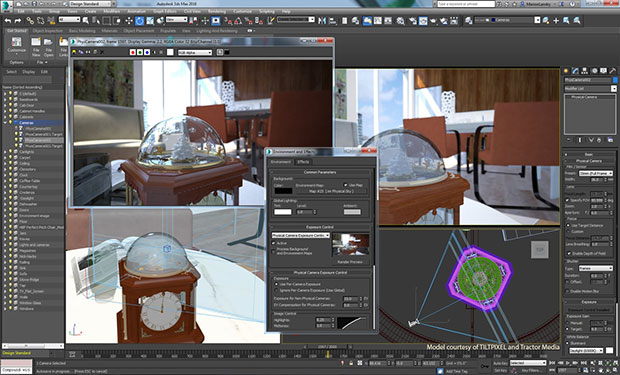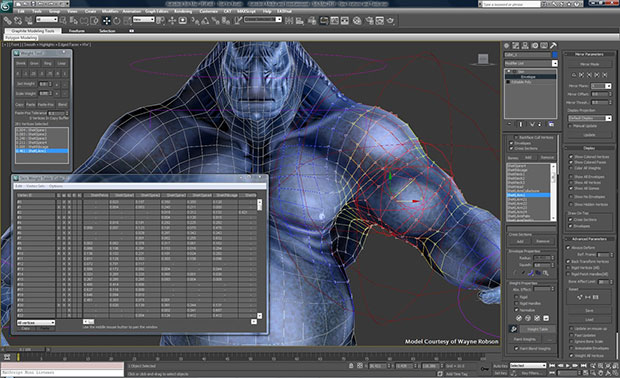
The beastly, famous, and highly polished Autodesk 3D Studio Max software has been a popular animation tool for over a decade, and it shows no signs of slowing down! 3ds Max 2019 has a whole new array of features to aid artists seeking to create 3D animations and VR (virtual reality) content in less time than in years before.
The famous Arnold renderer is a MAXtoA plug-in that is now integrated into 3ds Max, giving users access to all of its latest features! 3ds Max fluids, motion paths, keyframe animation tools, and procedural animation tools have all improved, including procedural animation for character rigs using CAT, biped, and crown animation tools. Need particle flow effects for water, fire, spray, and snow? You have it. Need geodesic voxel and heatmap skinning for better skin weighting? All yours. Don’t want to animate at all, and instead simulate animations based off data imported from CFD, CSV, or OpenVDB format files? All doable! Still not satisfied, and want to make your own author animation controllers, using a new generation of animation tools that you can create, modify, package, and share? Then 3ds Max 2019 has what you need.

Render fanatics will be pleased to know there’s a plethora of VR visualization options, as well as ActiveShade rendering for quicker iterations of your work. Want a more traditional, realistic approach? No problem. The physical camera allows real life camera settings including shutter speed, aperture, depth of field, exposure, and plenty of other options. Autodesk Raytracer Renderer (ART) has been improved and there’s even a new scene layout in VR for those of you animating with cutting edge industry goals.
The user interface continues to improve, with an Asset Library that lets you browse all the 3D content on your local computer and network in a single view. More flexible smart asset packaging are now present, and pipeline tool improvements have been added for artists using Python or .NET toolsets. Artists who don’t care that much about all of the above and instead just want to retain their old workspaces, guess what? You now have even more custom workspace options, including high-DPI user interface options for better responsiveness!

Gone are the days of digital artists using only a few pieces of software. To combat this neverending process of software expansion, 3ds Max 2019 is now more seamless from one renderer to another, so that switching is less of a headache, and less noticeable, in your pursuit of completing a project. Vehicles in CivilView now even support a 3ds Max physical material, which reduces the conversion and simplifies the render. Switching projects is now easier, as is accessing more folder structure options, and some users will be thrilled to know that sharing models online directly via the Autodesk Viewer within the 3ds Max interact is now just a simple button click! Artists on social media, eat your hearts out!
Spline workflows now let you create and animate geometry in several new intuitive ways with the enhanced spline tools. Obsessed with learning? The Data Channel Modifier lets you extract way more data from a model, which will let you better understand how modifications in your project are actually functioning, giving you a deeper look under the hood of the software. Blended Box Map allows users to morph visible seams by blending as many as six materials applied to an object, and you can even create OSL maps (Open Shading Language) in the material editor from simple math nodes to create procedural textures! On top of that, you can also create a wood texture from a variety of wood types, growth rates, and finishes, all based on the wood textures from Fusion 360. I can’t wait to see how these changes will improve the textures across the entire entertainment industry!
Other new features include now selection and styling tools for hair and fur modifiers within viewport, parametric Boolean operations on two or more splines with the familiar user interface (UI) from 3D Booleans.

Students can obtain 3ds Max for free for three years. Everyone else currently has four options to choose from. The baseline is $1505 a year, with flexible options. The Media & Entertainment Collection includes the baseline, plus Arnold, plus more, for $2,095 a year. The Architecture, Engineering & Construction Collection package includes the baseline, plus Revit, plus more, all for $2,775 a year. Lastly, the package for Product Design & Manufacturing Collection has the baseline 3ds Max, plus Inventory, plus more, all for $2,525 a year. Your minimum system requirements will vary depending on which 3ds Max software path your project needs. There’s a free trial available to everyone, so what are you waiting for? Download it and get started in pursuing your wildest dreams!

